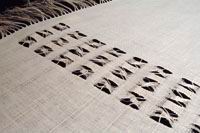Oľga Danglová
A graduate of the secondary textile school and ethnography at the Faculty of Philosophy of Comenius University, since 1956 she has worked for more than thirty years in the Centre for Folk Art as its renowned art employee with specialization in woven textile. The inspiration for Oľga Koreňová was the folk tradition and folk craft. A special part of her textile production was her cooperation with folk weavers. Through these contacts she improved her own artistic intent, use of patterns and shape solutions. She searched for and discovered new talents and, in dialogue with them, sought a common platform. No doubt because she herself was skilled behind the loom, she was able to sensitively catch and use the potential of technical skill and craft maturity specific for each individual weaver. In her first designs, the fact that she clings to the inspiration of folk material is obvious. However, Oľga Koreňová then left behind reconstructions of old patterns and the use of old pattern books and instead started to search individually for her own artistic unknowns and untried paths. Her artistic designs now change to contemporary fashions and topical requirements. However, like the traditional folk textile, she uses only natural fibres – flax, cotton and wool. Her rugs are a special chapter in the creation of woollen textile, whereby she combined creative fantasy with the plasticity of surface. She used the simple impressive effect of the technique of weaving on a form for designing carpets, covers and pillows, which gave them a new dimension. When designing utilitarian interior textiles from natural flax and cotton threads, she devoted herself to frequently used and known techniques from Slovak folk fibre. Using a wide palette of regional patterns of traditional fibre, she chose according to the craft value and design shape. In the 1980s she used the openwork technique of weaving from thin flax threads, a technique common around Trebišov in Eastern Slovakia. Woven openwork gave her the possibility for various rhythmical solutions: the ability to spread patterns in space and the advantage of creating motifs in any shape. This precious transparent textile remains an integral part of the creative repertoire of ÚĽUV. She followed the authenticity of ornamental elements in whole-area or strip-shaped pattern design. However, she used traditional motifs in compositional and technical solutions. She preferred abstract geometric elements, simple geometric area solutions, strip compositions in various variable solutions. Despite being inspired by many impulses, she decided to exclude highly decorative compositions used during the last developmental state of folk material. Even though she respected the colourfulness of folk material, she calmed down their glittering colourfulness in order to respect the needs of contemporary interiors. She preferred to choose from natural brown shades used on a white background. With other colours she used light tones. Oľga Koreňová, in accordance with the lifestyle, environment and culture of the second half of the twentieth century, was sure about textile handicraft. From the wide scale of woven variety this utilitarian material as an interior design element was the closest to her. She created very many materials: covers, tablecloths, lunch or tea sets, table settings or sets. In addition, she created goblins, woven covers, pillows and carpets in woven material. The products created in the design workshop of Oľga Koreňová have always been and remain a key and current part of the production programme of ÚĽUV.
